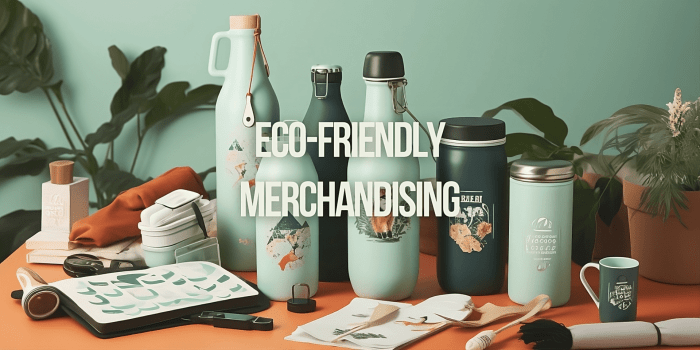Exploring the realm of Eco-Conscious Merchandise for Lifestyle Brands, this introduction sets the stage for a captivating journey into the world of sustainable practices and environmentally friendly products. From innovative materials to mindful design considerations, this topic delves into the intersection of fashion and sustainability with a focus on creating a better future for our planet.
As we delve deeper into the various aspects of eco-conscious merchandise, we uncover the key elements that define this growing trend in the retail industry. From manufacturing processes to branding strategies, each component plays a crucial role in shaping the landscape of sustainable fashion for lifestyle brands.
Eco-Conscious Materials
Choosing sustainable materials for eco-conscious merchandise is essential in reducing the environmental impact of production and consumption. These materials are sourced ethically and are often biodegradable or recyclable, making them a better choice for the planet.
Examples of Sustainable Materials
- Organic Cotton: Grown without harmful chemicals, organic cotton reduces water usage and pesticide contamination.
- Bamboo: Fast-growing and renewable, bamboo is a versatile material that requires minimal resources to grow.
- Recycled Polyester: Made from post-consumer plastic bottles, recycled polyester helps divert waste from landfills.
- Hemp: Known for its durability and minimal need for pesticides, hemp is a sustainable alternative to traditional fabrics.
Environmental Impact of Using Eco-Conscious Materials
By opting for eco-conscious materials, brands can significantly lower their carbon footprint and contribute to a more sustainable future. These materials often have a smaller environmental footprint in terms of water usage, energy consumption, and chemical pollution compared to traditional materials.
Cost and Durability Comparison
While eco-conscious materials may initially have a higher cost due to production methods and sourcing, they often provide better durability in the long run. Investing in quality sustainable materials can result in products that last longer, reducing the need for frequent replacements and ultimately saving money over time.
Design Considerations

When incorporating eco-conscious elements into the design of merchandise, it is essential to prioritize sustainability without compromising visual appeal. By considering various factors such as materials, production processes, and end-of-life options, brands can create products that are both environmentally friendly and aesthetically pleasing.
Tips for Creating Visually Appealing Eco-Friendly Products
- Choose natural and organic materials that are renewable and biodegradable, such as organic cotton, bamboo, hemp, or recycled fabrics.
- Opt for minimalist designs that are timeless and versatile, reducing the need for frequent replacements and promoting a more sustainable lifestyle.
- Incorporate eco-friendly colors and dyes that are non-toxic and safe for both the environment and consumers.
- Consider the entire lifecycle of the product, from sourcing materials to production, packaging, and disposal, to minimize environmental impact at every stage.
- Collaborate with eco-conscious artists and designers who share the brand's commitment to sustainability, bringing fresh perspectives and innovative ideas to the table.
Examples of Successful Designs Prioritizing Eco-Friendliness
- A clothing brand that uses recycled plastic bottles to create stylish activewear, reducing plastic waste and promoting a circular economy.
- An accessories brand that partners with local artisans to handcraft jewelry from sustainably sourced wood and natural fibers, supporting traditional craftsmanship and biodiversity conservation.
- A home decor brand that offers modular furniture made from upcycled materials, allowing customers to customize and reconfigure their pieces over time, reducing waste and promoting longevity.
- A beauty brand that packages its products in biodegradable containers and offers refill options to minimize single-use plastic packaging, encouraging customers to reduce their environmental footprint.
Manufacturing Processes

Manufacturing eco-conscious merchandise involves sustainable practices that minimize environmental impact and prioritize ethical standards throughout the production process. By adopting eco-friendly manufacturing techniques, lifestyle brands can reduce their carbon footprint and contribute to a more sustainable future.
Sustainable Manufacturing Practices
- Utilizing renewable energy sources such as solar or wind power to power manufacturing facilities.
- Implementing water recycling systems to reduce water consumption and minimize wastewater discharge.
- Choosing eco-conscious materials like organic cotton, recycled polyester, or bamboo for production.
- Optimizing production processes to minimize waste and energy consumption.
Ethical Standards Compliance
- Ensuring fair labor practices by providing safe working conditions and fair wages for factory workers.
- Regularly auditing manufacturing facilities to monitor compliance with ethical standards and regulations.
- Prioritizing transparency in the supply chain to trace the origins of materials and ensure ethical sourcing.
Challenges and Benefits of Eco-Friendly Manufacturing
- Challenges:
- Initial investment costs for transitioning to sustainable manufacturing practices.
- Finding suppliers and partners that share the same commitment to eco-conscious principles.
- Adapting existing production processes to meet environmental standards.
- Benefits:
- Reduced environmental impact and carbon emissions.
- Enhanced brand reputation and consumer trust in sustainability efforts.
- Long-term cost savings through energy efficiency and waste reduction.
Marketing and Branding
When it comes to marketing eco-conscious merchandise to consumers, it is essential to highlight the sustainability aspects of the products. By emphasizing the eco-friendly materials used, the ethical manufacturing processes, and the positive impact on the environment, brands can attract customers who prioritize sustainability in their purchasing decisions.
Importance of Branding in Conveying Sustainability Values
Branding plays a crucial role in conveying sustainability values to customers. By creating a strong brand identity centered around eco-consciousness, companies can build trust with consumers who are looking for environmentally responsible options. A clear and consistent message about sustainability in branding helps to differentiate a brand in a crowded market and attract like-minded consumers.
Examples of Lifestyle Brands Promoting Eco-Conscious Products
- Patagonia: Patagonia is well-known for its commitment to sustainability. The brand not only uses eco-friendly materials in its products but also actively promotes environmental activism and conservation efforts.
- Allbirds: Allbirds is a footwear brand that has gained popularity for its use of sustainable materials like merino wool and eucalyptus fibers. The company transparently communicates its commitment to sustainability in all aspects of its branding.
- Reformation: Reformation is a fashion brand that focuses on sustainable practices, such as using deadstock fabrics and eco-friendly manufacturing processes. The brand's marketing campaigns highlight the environmental benefits of choosing their products.
Conclusive Thoughts
In conclusion, Eco-Conscious Merchandise for Lifestyle Brands offers a glimpse into a world where environmental consciousness meets consumer demand. By prioritizing sustainability and ethical practices, brands can not only attract eco-conscious consumers but also contribute to a greener and more responsible industry.
As we continue to embrace eco-friendly initiatives, the future of fashion looks brighter and more sustainable than ever before.
Popular Questions
What are some examples of sustainable materials suitable for eco-conscious merchandise?
Common examples include organic cotton, recycled polyester, hemp, bamboo, and Tencel.
How can brands effectively market eco-conscious merchandise to consumers?
Brands can leverage social media, storytelling, and collaborations with influencers to reach eco-conscious consumers.
What are the challenges of implementing eco-friendly manufacturing techniques?
Challenges include higher initial costs, finding sustainable suppliers, and ensuring compliance with eco-friendly standards.









